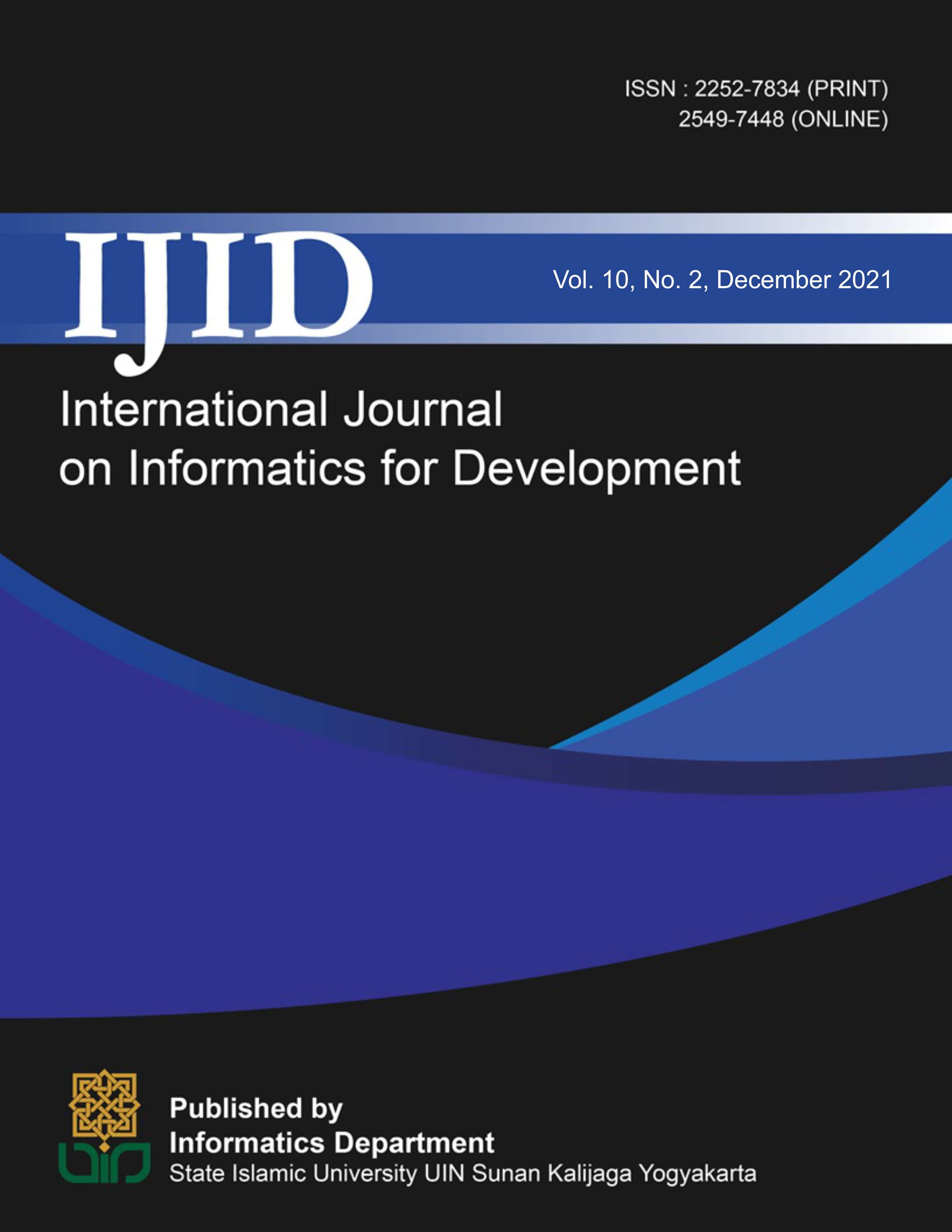Abstract
The Indonesian government launched the Prakerja (pre-employment) card in the midst of the COVID-19 pandemic, and
the local citizens have voiced their opinions about this controversial program through social media such as Twitter. People’s
comments on it can be useful information, and this research tries to analyze the sentiment regarding the Prakerja Card program
using the Convolutional Neural Network and Naive Bayes methods. The main task in this sentiment analysis is analyzing the data
and then classifying them into one of the following classes: positive, negative or neutral. Naive Bayes is an algorithm that is often used
in sentiment analysis research, and the results have been very good. Convolutional neural network (CNN) is a deep learning algorithm
that uses one or more layers commonly used for pattern recognition and image recognition. Having applied these methods, this
research found that the CNN model with the GlobalMaxPooling layer is the best model of the other two CNN models. Sentiment
analysis has the best accuracy of 78.5% on the CNN method, and NBC of 76.2% accuracy. The best accuracy result in K-fold with
five classes is 85.4% on the CNN model with a learning rate optimization of 0.00158. While the average accuracy on NBC only reached
75.3%
References
C. Akbar, “Pandemi COVID-19, Airlangga: Pekerja Yang Di- PHK Naik Jadi 2,1 Juta Orang,” Tempo.co, 2020.
A. D. Handayani and A. Rachman, “Dampak Pandemi COVID-19 Terhadap Motif dan Tren Penelusuran Informasi Kartu Prakerja di Indonesia,” Empower J. Pengemb. Masy. Islam, vol. 5, no. 2, p. 111, 2020, doi: 10.24235/empower.v5i2.7187.
M. P. K. Prakerja, “Apa Itu Program Kartu Prakerja?,” Kementerian Koordinator Bidang Perekonomian Republik Indonesia.
F. Ronen and J. Sanger, The Text Mining Handbook : Advanced Approaches in Analysing Unstructured Data. New York, NY, USA: Cambridge University Press, 2007.
Ii. Budiman, M. R. Faisal, and D. T. Nugrahadi, “Studi Ekstraksi Fitur Berbasis Vektor Word2Vec pada Pembentukan Fitur Berdimensi Rendah,” J. Komputasi, vol. 8, no. 1, pp. 62–69, 2020, doi: 10.23960/komputasi.v8i1.2517.
M. Chalida and M. D. R. Wahyudi, “Analisis Sentimen Ujaran Kebencian Pemilihan Presiden 2019 Menggunakan Algoritma Naïve Bayes (Studi Kasus: Tweet #Pilpres2019 Di Kota Jakarta, Bandung, Semarang, Surabaya Dan Yogyakarta),” Jnanaloka (Jurnal Open Access Yayasan Lentera Dua Indones., no. 2001, pp. 5–10, 2019.
A. F. Hidayatullah and R. A. N. Nayoan, “Analisis Sentimen Berbasis Fitur Pada Ulasan Tempat Wisata Menggunakan Metode Convolutional Neural Network(CNN),” 2019.
D. Prasetyawan and S. ’Uyun, “Penentuan Emosi Pada Video Dengan Convolutional Neural Network,” JISKA (Jurnal Inform. Sunan Kalijaga), vol. 5, no. 1, p. 23, 2020, doi: 10.14421/jiska.2020.51-04.
M. H. Widianto, “Algoritma Naive Bayes,” Binus Univesity, 2019.
J. Wang, L. C. Yu, K. R. Lai, and X. Zhang, “Dimensional sentiment analysis using a regional CNN-LSTM model,” 54th Annu. Meet. Assoc. Comput. Linguist. ACL 2016 - Short Pap., pp. 225–230, 2016, doi: 10.18653/v1/p16-2037.
M. Theo and A. Bangsa, “Analisis Sentimen Berbasis Aspek Pada Ulasan Toko Online Menggunakan Convolutional Neural Network MHD. THEO ARI BANGSA, Dr. Yohanes Suyanto, M.I.Kom; Dr. Sigit Priyanta, S.Si, M.Kom,” pp. 84–85, 2019.
A. Deviyanto and M. D. R. Wahyudi, “Penerapan Analisis Sentimen Pada Pengguna Twitter Menggunakan Metode K-Nearest Neighbor,” JISKA (Jurnal Inform. Sunan Kalijaga), vol. 3, no. 1, p. 1, 2018, doi: 10.14421/jiska.2018.31-01.
B. Gunawan, H. S. Pratiwi, and E. E. Pratama, “Sistem Analisis Sentimen pada Ulasan Produk Menggunakan Metode Naive Bayes,” J. Edukasi dan Penelit. Inform., vol. 4, no. 2, p. 113, 2018, doi: 10.26418/jp.v4i2.27526.
J. A. Septian, T. M. Fahrudin, and A. Nugroho, “Analisis Sentimen Pengguna Twitter Terhadap Polemik Persepakbolaan Indonesia Menggunakan Pembobotan TF-IDF dan K-Nearest Neighbor,” J. Intell. Syst. Comput., pp. 43–49, 2019.
A. Hendra and F. Fitriyani, “Analisis Sentimen Review Halodoc Menggunakan Nai ̈ve Bayes Classifier,” JISKA (Jurnal Inform. Sunan Kalijaga), vol. 6, no. 2, pp. 78–89, 2021, doi: 10.14421/jiska.2021.6.2.78-89.
A. R. Susanti, T. Djatna, and W. A. Kusuma, “Twitter’s sentiment analysis on GSM services using Multinomial Naïve Bayes,” Telkomnika (Telecommunication Comput. Electron. Control., vol. 15, no. 3, pp. 1354–1361, 2017, doi: 10.12928/TELKOMNIKA.v15i3.4284.
S. D. Harijiatno, “Analisis Sentimen Pada Twitter Menggunakan Multinominal Naive Bayes,” J. Phys. A Math. Theor., vol. 8, no. 5, pp. 1–104, 2019.

This work is licensed under a Creative Commons Attribution-NonCommercial-NoDerivatives 4.0 International License.
